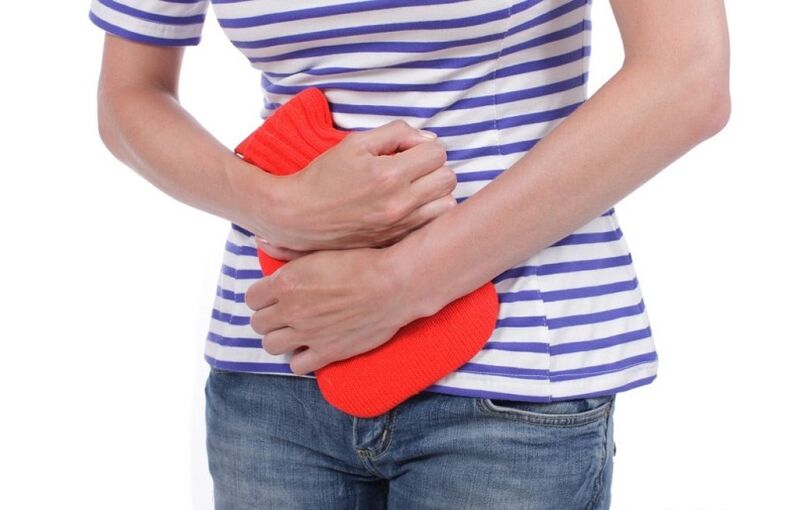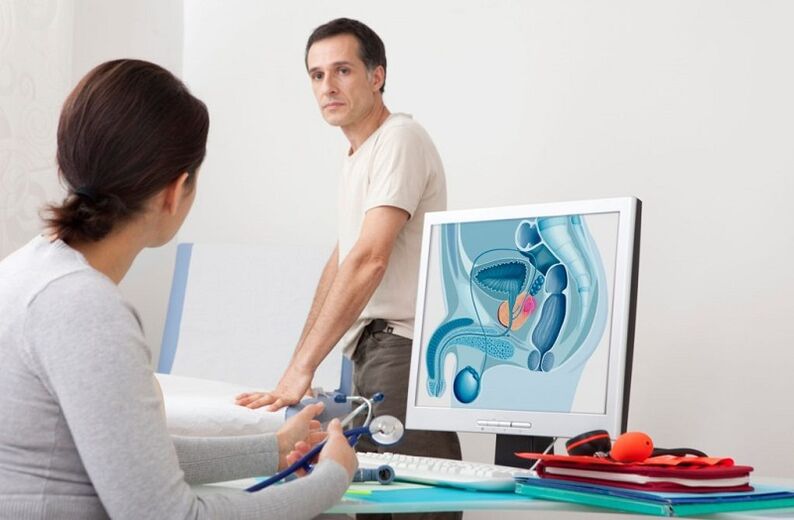Acute prostatitis is an infectious and inflammatory disease that affects the tissues of the prostate gland, causing extensive swelling and the appearance of purulent foci. The disease can manifest itself in different ways, depending on the stage of development. Therefore, an integrated approach is required for accurate diagnosis. Treatment of acute prostatitis is mostly based on medication and physiotherapy.
Reasons

Alcoholism can cause acute prostatitis.
The disease most often develops in men over 30 years. In most cases, the disease develops as a result of the negative impact of pathogenic microflora on the male body. Thus, acute prostatitis in men can be triggered by the activity of the following microorganisms:
- Staphylococcus aureus;
- Pseudomonas aeruginosa and Escherichia coli;
- klebsiella;
- enterococci;
- Proteus.
Most of the above microorganisms are always present in the human body, no inflammation is observed. When such bacteria enter the tissues of the prostate gland, they begin to actively multiply, resulting in severe inflammation of the prostate.
Bacteria can enter the genitourinary system during unprotected sex. Therefore, it is very important for people who do not have regular sexual partners to use condoms.
Inflammation can also be non-infectious in nature for the following reasons:
- obesity;
- sedentary lifestyle;
- rare sexual intercourse;
- significant hypothermia;
- disconnection;
- eating disorders;
- smoking and alcohol abuse.
The above factors create a fertile ground for the stagnation of prostate secretion. At the same time, stagnant blood processes are noted in the vessels located near the body.
Significant accumulation of prostate secretions creates a favorable environment for the proliferation of pathogenic microflora. As a result, the inflammatory process develops. Second, it can cause a number of complications:
- BPH;
- abscess;
- oncology process.
It is important!Against the background of acute prostatitis, most men have a problem with strength and are at risk of infertility.
Thus, the risk group for the development of this disease includes:
- there is no regular sex life;
- have a lack of physical activity;
- have bad habits.
Forms and stages

You should go to the hospital immediately for any signs of prostate discomfort.
In modern medicine, there are three main stages of this disease. Let's look at them in more detail:
- The first stage is called catarrhal.The presence of glandular tissue edema is characterized by the occurrence of a primary inflammatory process with the expansion of pain. In this case, the prostate gland grows. If the disease is not treated, the inflammation gradually spreads to the secretory ducts of the prostate glands connected to the back of the urethra. Inflammation of the prostate ducts causes them to gradually narrow and become blocked, making the process of prostate secretion more difficult. In the catarrhal stage of development, the inflammatory process involves only the mucous membranes.
- This is followed by the follicular stage of the disease.It is characterized by a further progression of the inflammatory process, in which the remaining tissues of the body are gradually involved. As a result, an acute form of bacterial prostatitis develops. At this stage of the disease, there is pus in the urine. However, despite the large amount of tissue damage, the follicular form of prostatitis responds well to treatment.
- The last stage is called parenchymal.It is characterized by a destructive change in the tissues of the prostate gland. At the same time, the swelling gradually grows, and the inflammatory process eventually covers the entire body. If the development of the disease reaches this stage, the treatment process is very complicated and requires radical measures. In the absence of timely and adequate treatment, chronic prostatitis can develop.
In the early stages of the disease, a subacute stage is usually chosen. It is characterized by the severity of a weak symptom, which is explained by the low activity of pathogens. If the patient's body resists well, the disease can be at this stage for a long time. At the same time, it is very difficult to diagnose the disease in the subacute stage, so most patients do not receive timely treatment.
Symptoms
Each of the forms of this disease is characterized by its own symptoms. Therefore, you should consider them separately.
Catarrhal form

This form of the disease is characterized by frequent urges to walk for less need.
If the infection has reached the secretory ducts, this stage of the disease develops. However, although the inflammatory process does not extend beyond the mucous membrane, the prostate gland grows and swells. In this case, the urethra is compressed.
At this stage, the symptoms of acute prostatitis are mild:
- the patient may experience minor problems with urination due to canal compression;
- at night, urination becomes more frequent;
- increase in body temperature to 38 degrees;
- When the patient is in a sitting position, he may feel some heaviness in the perineum.
In some cases, the catarrhal form occurs without severe hyperthermia.
Symptoms of the disease may disappear spontaneously within a few weeks of development. And in this case, most patients do not go to the doctor. However, this is fraught with the disease becoming chronic. The disease is withdrawn after 10 days, provided that the treatment of acute prostatitis is started on time.
Follicular form
When the catarrhal stage is not treated, the disease progresses further, affecting the individual lobes of the body. In this case, the obvious symptoms appear:
- acute pain observed during urination;
- the patient's body temperature is maintained at about 38 degrees;
- a dull pain appears in the perineum spreading to the penis;
- the process of urination is complicated;
- The patient has difficulty urinating due to severe pain.
Because this stage is characterized by a purulent lesion of the prostate, pus may be present in the patient's urine. Provided timely therapy, complete cure of the disease at this stage occurs less than two weeks after the start of procedures.
Parenchymal form
This is called diffuse. As the inflammatory process covers the whole body, the following symptoms occur:
- Perineal pain is almost unbearable. Periodically, they move to the penis. When the patient presses both feet to the chest, a slight analgesia is possible during sleep.
- Sensation of a foreign body in the rectum. There is significant pain in bowel movements. Constipation is more common, and if the inflammatory process becomes a reactive form, mucus secretion begins in the anus.
- There are serious problems with urination. In this case, both partial and complete urination is possible.
- Body temperature can reach 40 degrees. The patient suffers from colds.
Diagnostics

A number of different studies are needed to make a definitive diagnosis.
The disease is diagnosed by a specialist urologist who conducts a comprehensive study covering the following types of procedures:
- physical examination;
- instrumental research;
- laboratory research.
During the initial examination of the patient, the specialist palpates the gland. This should be done very carefully, avoiding massage movements and strong pressure. Otherwise, you can cause significant discomfort to the patient.
The main diagnostic method is to study the prostate gland by placing a probe in the rectum. This procedure allows professionals to obtain the following information:
- determine the pain response;
- identify key sites of destruction;
- to confirm or deny the signs of purulent tissue fusion;
- evaluates the shape and symmetry, size and consistency of the body.
As a rule, palpation of the prostate emphasizes the secretion of this organ. Its analysis allows you to accurately determine the presence of an inflammatory process. The test checks the number of leukocytes, amyloid bodies and other components.
- bacterial culture of urine and urinary tract with antibiotics;
- PCR studies of debris;
- blood culture for blood culture.
In the acute course of the disease, the nature and severity of dysuric disorders are assessed using uroflowmetry.
Ultrasound of the prostate gland with moderate pain syndrome can be performed transrectally, and in case of severe pain reaction transabdominally. Ecoscopically, the presence of glandular shape, size, focal or diffuse changes is assessed, the stage of the acute inflammatory process is established.
When planning surgery for destructive forms of acute prostatitis, MRI of the pelvic region is recommended.
Treatment of the disease
The mainstay of treatment for acute prostatitis is etiotropic therapy. It is based on the timely appointment of antimicrobial drugs to the patient, which will prevent the further development of pathogenic microflora in the pelvic organs. In addition to medications, the patient is prescribed folk remedies and physiotherapy procedures. A balanced diet plays an important role in the treatment of acute prostatitis.
Medications
Treatment of acute prostatitis should include eliminating the infection that is causing the inflammation. In addition, the task of therapy is to eliminate stagnation and normalize the circulatory process.
In most cases, outpatient treatment is used for patients with acute prostatitis. If the patient has a parenchymal form of the disease, then he is hospitalized.
Treatment of acute infectious prostatitis necessarily involves the use of antibiotics. In this case, the duration of treatment is determined by a specialist, such as the drugs used.
Antibiotics of different groups are active against different microorganisms. Therefore, professional treatment is carried out only on the basis of a comprehensive diagnosis. Thus, the doctor will be able to choose exactly the remedy that will be effective against a particular pathogen. In general, treatment is carried out using drugs of these groups:
- fluoroquinolones;
- penicillins;
- macrolides.
The first is considered the most effective. For this reason, it is most often used in the treatment of acute prostatitis.
Although antibiotics are the mainstay of treatment, they are not the only drugs used for acute prostatitis. Especially patients are prescribed antihistamines and intestinal friendly bacteria.
It is very important to stimulate the immune system at all stages of treatment of acute prostatitis. For this reason, patients are prescribed immunostimulating drugs.
In addition to the above agents, interferons are used in the treatment of acute prostatitis. Such drugs can be taken both in tablet form and by intramuscular injection. The latter option is preferred.
Physiotherapy
Properly selected drug treatment of acute prostatitis significantly reduces the severity of symptoms of this disease. The following physiotherapeutic methods are used to combine the results:
- Microwave and UHF therapy;
- rectal electrophoresis;
- prostate massage.
Folk remedies

Many experts claim that acute prostatitis cannot be treated with traditional medicine alone. In addition, such self-medication can greatly aggravate the disease, which leads to a number of complications. In this case, folk recipes can be used only in addition to official medicines. In addition, many pharmaceuticals are made from different plants.
As a rule, patients with an acute form of prostatitis are prescribed various infusions and mixtures. It should be taken orally while taking a bath or used to obtain a healing solution. The most effective in this situation are the following plants:
- chestnut;
- mother and stepmother;
- field ponytail;
- Oak bark;
- chamomile
Dietary food
The key to treating acute prostatitis is a balanced diet. The inclusion of some products in the patient's weekly menu is based on the severity of his illness. However, regardless of the stage of the disease, the following foods should be excluded from the diet for some time:
- smoked meats;
- fried foods;
- conservation;
- strong tea and coffee;
- alcoholic beverages;
- spicy and salty foods;
- oily fish and meat.
Prophylaxis

Exercise is very useful for the prevention of prostate diseases.
Prevention of acute prostatitis includes timely elimination of the inflammatory process. To do this, it is necessary to treat bacterial, fungal and viral diseases in a timely manner. At the same time, any medical manipulation related to endouretral or endovesic examinations should be performed in accordance with appropriate aseptic procedures.
Effective prevention of acute prostatitis is based on the following principles:
- Strengthening the immune system.
- Genital hygiene.
- Live a regular sex life.
- Systematic physical activity and walking in the fresh air.
- Give up bad habits.
- Normalization of diet.
Periodic prostate massage can be an excellent prevention of a number of urological diseases.
If you see the first signs of prostatitis, do not hesitate - you should consult a specialist as soon as possible. This will help to cure the disease faster and prevent a number of negative consequences.





































